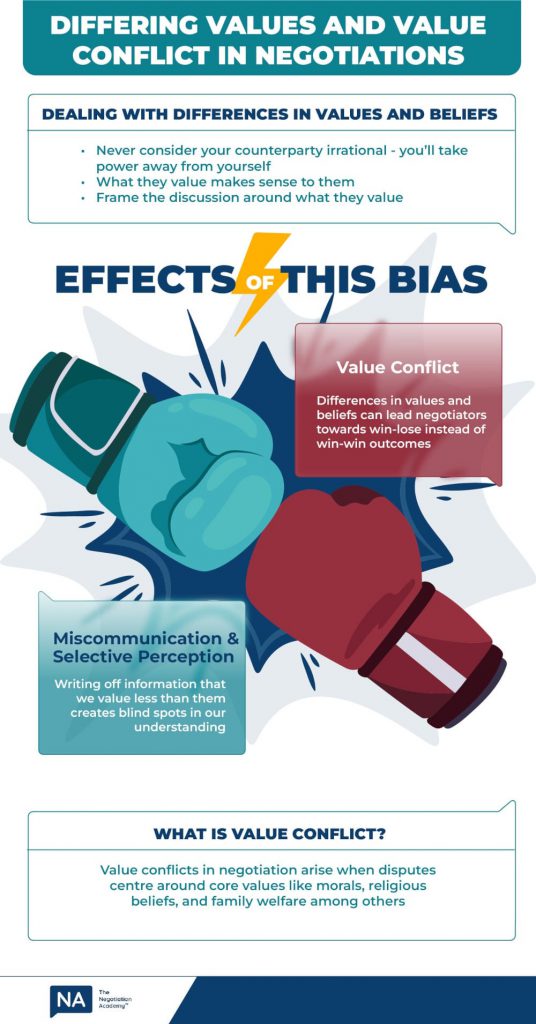
Welcome back to our series on cognitive biases in negotiation!
So far in our cognitive bias series, we’ve covered prospect theory and selective perception. Prospect theory shows how we can be affected by something framed as a gain or loss. Selective perception happens when we zoom in on information that supports what we believe or want to see while ignoring other information.
Now we’re moving on to biases based on our beliefs, the counterparty’s beliefs, and even what we believe about the counterparty.
Ever had an impression of someone, and after meeting them they reinforced what you felt? What if others see that individual in a completely different light? Would that impact how you treat them in a negotiation?
If you answered no, you’ll still need to be cautious and catch yourself thinking that way in negotiations, as we explore further below.
Values and Beliefs and Value Conflicts

Value conflicts arise around core values such as morals, religious beliefs, and family welfare.
Values and beliefs shape how we perceive information and can create blind spots in negotiations. For instance, if a negotiator values short-term gains over long-term relationships, they might disregard offers that could benefit them in the long run.
Another pitfall we should consider is how we think of the counterparty. Never assume that they are irrational or you’ll take power away from yourself (!). Find out how they think and what they value and then try framing things around that. Even if it initially appears irrational to us, what they value still makes sense to them, so we can appeal to that.
Consider a company prioritizing profit over employee well-being. This value system might lead them to overlook proposals that could improve workplace morale, ultimately affecting productivity. One great example is the tension between companies and worker’s unions.
During collective bargaining agreements between businesses and worker’s unions, many different examples of how values and beliefs interfere with negotiations abound:
In this scenario, the corporation values profitability, operational efficiency, and maintaining control over workplace policies. In contrast, the union prioritizes fair wages, job security, healthcare benefits, and safe working conditions for its members. These differing priorities can lead to significant challenges in negotiations.
Impasses
Differing values often lead to impasses during negotiations. For instance, the union might push for pay raises, citing the rising cost of living and the need for fair compensation. On the other hand, the corporation might resist these demands, arguing that significant wage hikes could hurt its competitive edge and financial stability.
Miscommunication
Differing values and beliefs can lead to misunderstandings and misinterpretations of the other party’s intentions and statements (Thompson, 2006).1
For example, workers could be so angry with the way they perceive their bosses have been treating them that they are unable to see or accept concessions given to them. Anger has been shown to impair our ability to perceive things in a neutral way, leading to miscommunication.2
Conflict, Tension and Reduced Collaboration
Deep-seated differences in values and beliefs can create underlying tension and conflict, making it harder to reach a consensus (Fisher & Ury, 1981).3 Also, when negotiators hold strongly opposing beliefs, they may be more likely to adopt a competitive rather than cooperative or collaborative approach (Lewicki, Barry, & Saunders, 2016).4
Business and workers’ union negotiations can become heated, with both sides finding it difficult to reach an agreement. The corporation might perceive the union’s demands as excessive and unfeasible, while the union sees the corporation’s resistance as prioritizing profits over people. This dynamic can lead to strikes, protests, and other forms of industrial action, which can be costly and damaging for both parties.
Sadly, with how heated these can get and how deep-seated each party’s assumptions about the other are —‘lazy and entitled workers’ vs. ‘greedy executives’—it can get quite challenging to find a win-win solution in many cases.
Reducing the Effect of Cognitive Biases
The same steps that can overcome selective perception biases and framing biases can help you overcome overconfidence, blind spots, and differing values and beliefs:
Prepare Well and Never Assume Anything
Being humble and never judging your counterparty too hastily as you prepare for the negotiation can help you overcome any prejudices you may harbor.
Preparation is 80 percent of your negotiation outcome. It can also give you insight into your counterparty even before you arrive at the negotiation table. For more, check out our preparation checklist.
Keeping an Open Mind
Never fall back into the ‘this is how we’ve always done it’ mindset. Monitor how you take in and process information.
Summarise and Reframe
You can summarise what your counterparty has said to ensure you haven’t left out or filtered anything they have said and understand their points correctly. Reframing their shared information can also help you avoid getting caught in gain/loss framing.
Think through and be honest while seeking the opinions of others
You can discuss and think through the negotiation’s progress with an assistant. During the discussion, you can objectively look through the strengths and weaknesses of your side and theirs.
Take Your Time
Never rush to a conclusion. We covered that thinking too quickly uses System 1 thinking that is fast but prone to biases. Give yourself enough time to use System 2 thinking and consider their statements, results, and options rationally and carefully to see if you’ve been subconsciously biasing your own understanding based on your own beliefs.
Negotiations are based on how well you communicate with your counterparty, so knowing their value and why can give you a major advantage. Similarly, we need to leave our prejudices at the door so that we don’t get blinded by our own beliefs and jeopardize the negotiation.
We share a lot of what we’ve learned by training businesses and law firms with their negotiation in our online courses and live sessions.
Joining one of our courses will put you on par with over 10,000 leading lawyers from Fortune 500 companies to Tier 1 law firms globally, boosting your negotiation skills to new heights.
If you want to see how these biases happen in real life, try one of our online courses or join a tailor-made live training session for your organization!
References:
- Pronin, E., Lin, D. Y., & Ross, L. (2002). The Bias Blind Spot: Perceptions of Bias in Self Versus Others. Personality and Social Psychology Bulletin, 28(3), 369-381.
- Communication Breakdowns: When All We Can See is Red – Programme On Negotiation Harvard
- Fisher, R., & Ury, W. (1981). Getting to Yes: Negotiating Agreement Without Giving In. Penguin Books.
- Lewicki, R. J., Barry, B., & Saunders, D. M. (2016). Negotiation. McGraw-Hill Education


